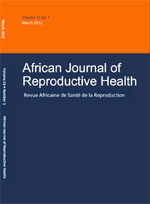
|
African Journal of Reproductive Health
Women's Health and Action Research Centre
ISSN: 1118-4841
Vol. 23, No. 2, 2019, pp. 27-34
|
 Bioline Code: rh19019
Bioline Code: rh19019
Full paper language: English
Document type: Research Article
Document available free of charge
|
|
|
African Journal of Reproductive Health, Vol. 23, No. 2, 2019, pp. 27-34
| en |
Is Prolonged Labor Managed Adequately in Rural Rwandan Hospitals?
Kalisa, Richard; Rulisa, Stephen; Akker, Thomas van den & Roosmalen, Jos van
Abstract
Unnecessary interventions to manage prolonged labor may cause considerable maternal and perinatal ill-health. We explored how
prolonged labor was managed in three rural Rwandan hospitals using a partograph. A retrospective chart review was done to
assess whether (A) the action line on the partograph was reached or crossed, (B) artificial rupture of membranes (ARM)
performed, (C) oxytocin augmentation instituted, and (D) vacuum extraction (VE) considered when in second stage of labor.
Adequate management of prolonged labor was considered if three clinical criteria were fulfilled in the first and four in the second
stage. Out of 7605 partographs, 299/7605 women (3.9%) were managed adequately and 1252/7605 women (16.5%) inadequately
for prolonged labor. While 6054 women (79.6%) remained at the left of the alert line, still 1651/6054 (27.3%) received oxytocin
augmentation unjustifiably. Amongst women whom were managed adequately for prolonged labor until their cervical dilatation
plot reached or crossed the action line. In 115/299 women (38.5%), however, second stage of labor was reached but CS
performed without a trial of VE. In 1252/7605 women (16.5%) management was inadequate, when their cervical dilatation plot
reached between the alert and action lines, 495/1252 women (39.5%) did not reach the second stage of labor and remained left of
the action line had their membranes ruptured and labor augmented, and gave birth by CS. CS was, however, also performed in
151/1252 women (12.1%) whose membranes were still intact. We recommend training for more appropriate decision-making
during labor to prevent unnecessary CS and proper use of ARM, oxytocin augmentation and VE can be provided safely. (Afr J
Reprod Health 2019; 23[2]: 27-34).
Keywords
Cesarean section; oxytocin; partograph; prolonged labor; vacuum extraction
|
| |
| fr |
Kalisa, Richard; Rulisa, Stephen; Akker, Thomas van den & Roosmalen, Jos van
Résumé
Des interventions inutiles pour gérer le travail prolongé peuvent entraîner de graves problèmes de santé maternelle et périnatale.
Nous avons exploré la gestion du travail prolongé dans trois hôpitaux ruraux rwandais à l'aide d'un partogramme. Une analyse
rétrospective des diagrammes a été réalisée pour déterminer si (A) la ligne d‘action sur le partogramme était atteinte ou croisée,
(B) une rupture artificielle des membranes (RAM) a eu lieu, (C) une augmentation de l‘ocytocine était instituée et (D) une
extraction sous vide (VE) a été prise en compte lors du deuxième stade du travail. Une gestion adéquate du travail prolongé était
envisagée si trois critères cliniques étaient remplis au premier et quatre au deuxième stade. Sur 7605 partogrammes, 299/7605
femmes (3,9%) étaient gérées de manière adéquate et 1252/7605 femmes (16,5%) de manière insuffisante pour un travail
prolongé. Alors que 6054 femmes (79,6%) sont restées à la gauche de la ligne d‘alerte, 1651/6054 (27,3%) ont quand même
bénéficié d‘une augmentation d‘ocytocine de manière non justifiable. Parmi les femmes qui ont été bien traitées pour un travail
prolongé jusqu‘à ce que leur dilatation cervicale atteigne ou croise la ligne d‘action. En 115/299 femmes (38,5%), cependant, le
deuxième stade du travail a été atteint mais l‘OC a été effectué sans essai de VV. Chez 1252/7605 femmes (16,5%), la prise en
charge était inadéquate, 495/1252 femmes (39,5%) n‘atteignaient pas le second stade du travail et restaient à gauche de la ligne
d‘action. Leurs membranes se sont rompues et le travail a augmenté et a donné naissance à l‘OC. L‘OC était cependant
également pratiquée chez 151/1252 femmes (12,1%) dont les membranes étaient encore intactes. Nous recommandons une
formation pour une prise de décision plus appropriée pendant le travail afin de prévenir les OC inutiles et l'utilisation appropriée
de la RAM, l'augmentation d'oxytocine et de VV peut être adoptée en toute sécurité. (Afr J Reprod Health 2019; 23[2]: 27-34).
Mots Clés
Opération césarienne; ocytocine; partogramme; travail prolongé; extraction sous vide
|
| |
© Copyright 2019 - African Journal of Reproductive Health
Alternative site location: http://www.ajrh.info
|
|
